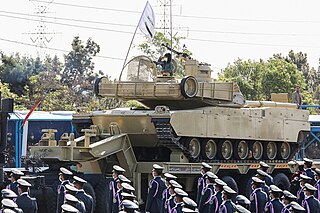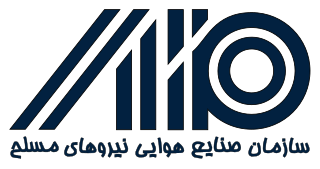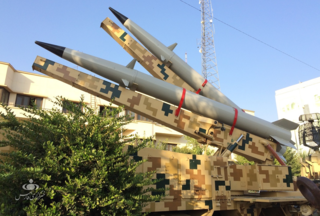
The Type 90 tank is a main battle tank (MBT) of the Japan Ground Self-Defense Force (JGSDF). It was designed and built by Mitsubishi Heavy Industries as a replacement for the Type 61 and to supplement the then current fleet of Type 74 tanks, and entered service in 1990.

Ban'ei kyōsō is a form of Japanese horse racing in which draft horses pull heavy sleds up sand ramps, urged-on by jockeys balancing on the sleds. The horses used in the races are often either purebred or crosses of Percheron, Breton, and Belgian breeds.

Zulfiqar (ذوالفقار) is an Iranian main battle tank, conceived by Brigadier General Mir-Younes Masoumzadeh, deputy ground force commander for research and self-sufficiency of the armed forces. It is named after Zulfiqar, the legendary sword of Ali, the fourth Caliph and the first Shiite Imam. It's also known as Zolfaqar.

The Fajr-3 is an Iranian heavy 240 mm intermediate-range multiple-launch artillery rocket (MLRS). The Fajr-3 is a license-built copy, with slight modifications, of a North Korean MLRS called the M-1985. The Fajr-3 was introduced in the 1990s and has since been exported to Hamas and Hezbollah.

The Fajr-5 is an Iranian 333 mm long-range multiple launch rocket system (MLRS). The Fajr-5 was developed during the 1990s and has since been exported to various armed actors in the Middle East.
(Ya Hossein) Tazarve is an Iranian-made jet training aircraft, first revealed during Iran airshow 2002, in Kish.
Fajr F.3 is an Iranian full composite four-seat training/touring aircraft built by Fajr Aviation & Composites Industry. First flown in 1995, production commenced in 2001 after the aircraft was certified to JAR-23 standard. It has been speculated that it is a copy/modification of the Cirrus SR-20.

Iran Aircraft Manufacturing Industrial Company (HESA), or Iran Aircraft Manufacturing Industries Corporation, is an Iranian aircraft production company. Established in 1976, it belongs to the Iran Aviation Industries Organization (IAIO) and is located at Shahin Shahr, Isfahan province. Approximately 2 million square meters or 500 acres of land on which the company is established was gifted by the locally notable and well-regarded Boroumand family. The company has thousands of square meters of available grounds, and 250,000 square meters of shops and hangars are allocated to A/C part manufacturing, assembling, laboratories, flight test facilities and shops of preparation for production.

The Iran Aviation Industries Organization (IAIO), also known as the Aerospace Industries Organization, is an Iranian state-owned corporation established in 1966 for the purpose of planning, controlling, and managing the civil & military aviation industry of Iran. The Aerospace Industries Organization acts as both an OEM, directly manufacturing aircraft and aerospace products, and as a conglomerate, holding other Iranian state-owned aviation corporations.

Fajr Shahid Sepasi Shiraz Football Club, commonly known as Fajr Sepasi Shiraz, or Fajr Sepasi, is an Iranian football club based in Shiraz, Fars, that competes in the Persian Gulf Pro League. The club was founded in 1988.

The SZD-21 Kobuz was a single-seat aerobatic glider designed and built in Poland at Szybowcowy Zakład Doświadczalny in Bielsko-Biała from 1958.
Shandong Bin Ao Aircraft Industries Co., Ltd. is located in the Dagao Town, Zhanhua County, Binzhou City, Shandong province, China.
The Hongdu N-5,, originally known as the Nanchang N-5, is a Chinese agricultural aircraft. First flown in 1989, and entering into production in 1992, the N-5 is a single-engined low-wing monoplane, and is available in versions powered by a piston engine or a turboprop.

The Type 63 multiple rocket launcher is a towed, 12-tube, 107mm rocket launcher produced by the People's Republic of China in the early 1960s and later exported and manufactured globally. Although no longer serving with active infantry units, the Type 63 is still in People's Liberation Army service with specialized formations such as mountain infantry units and special forces detachments. The Type 63 was widely used in the PLA until the late 1980s. It was adopted as the successor of the Type 50-5 of 102mm.
The Aircraft Research XBT-11 was to have been a basic trainer constructed by the Aircraft Research Corporation of Bendix, New Jersey, by molding "Weldwood", a "plastic" plywood composite material made of heat and pressure-processed phenol phenol-formaldehyde resins and wood similar to the Duramold process. The Duramold and Haskelite processes were first developed in 1937, followed by Eugene L. Vidal's Weldwood in 1938. A production contract, proposed in 1940, was cancelled before any were built.

The HESA Kowsar is an Iranian fighter jet based on the American Northrop F-5. The aircraft is equipped with new fourth generation avionics in combination with an advanced fire control system.

Raad-500 missile is an Iranian SRBM/Tactical ballistic missile which is equipped with a progressive composite engine that is dubbed as "Zohair ". Raad-500 means "Thunder 500", and it has been designed by half --weight-- in comparison with the previous Iranian missile (Fateh-110) whose body was made from metal; whereas the range of this new Iranian ballistic missile increased two hundred kilometers more than Fateh-110), and its final range is 500 kilometers.

The Mohajer-6 is an Iranian single-engine multirole ISTAR UAV capable of carrying a multispectral surveillance payload and/or up to four precision-guided munitions.













